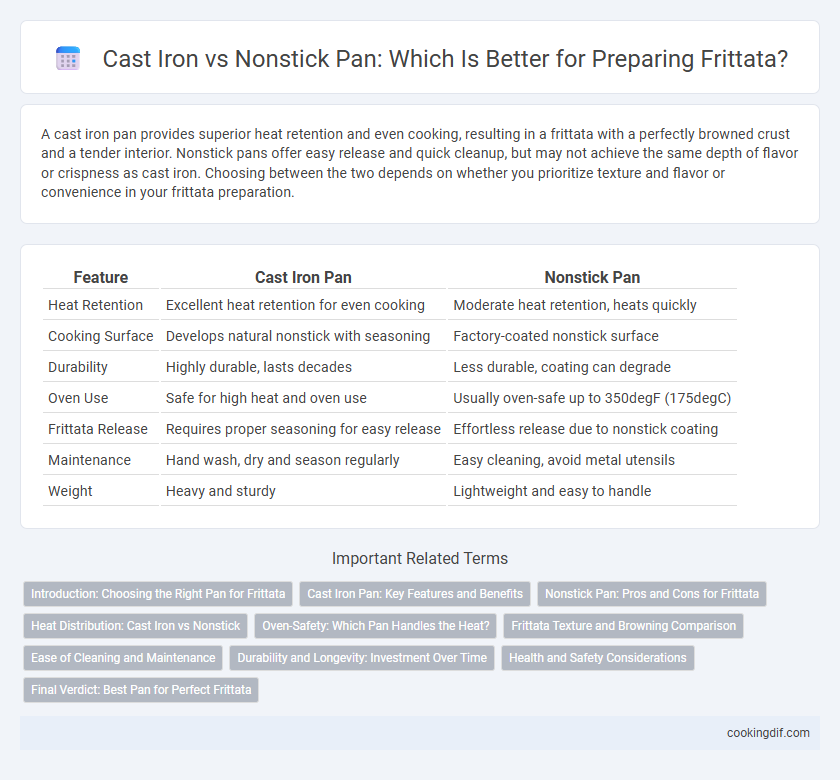A cast iron pan provides superior heat retention and even cooking, resulting in a frittata with a perfectly browned crust and a tender interior. Nonstick pans offer easy release and quick cleanup, but may not achieve the same depth of flavor or crispness as cast iron. Choosing between the two depends on whether you prioritize texture and flavor or convenience in your frittata preparation.
Table of Comparison
| Feature | Cast Iron Pan | Nonstick Pan |
|---|---|---|
| Heat Retention | Excellent heat retention for even cooking | Moderate heat retention, heats quickly |
| Cooking Surface | Develops natural nonstick with seasoning | Factory-coated nonstick surface |
| Durability | Highly durable, lasts decades | Less durable, coating can degrade |
| Oven Use | Safe for high heat and oven use | Usually oven-safe up to 350degF (175degC) |
| Frittata Release | Requires proper seasoning for easy release | Effortless release due to nonstick coating |
| Maintenance | Hand wash, dry and season regularly | Easy cleaning, avoid metal utensils |
| Weight | Heavy and sturdy | Lightweight and easy to handle |
Introduction: Choosing the Right Pan for Frittata
Cast iron pans provide even heat distribution and excellent heat retention, making them ideal for achieving a perfectly cooked frittata with a crisp edge. Nonstick pans offer convenience and easy release, allowing for effortless flipping and cleaning during frittata preparation. Selecting the right pan depends on desired texture and cooking style, with cast iron favored for rustic, well-browned frittatas and nonstick preferred for quick, delicate eggs.
Cast Iron Pan: Key Features and Benefits
Cast iron pans provide exceptional heat retention and even cooking, which is ideal for achieving a perfectly set frittata with a crispy bottom. Their natural non-stick surface improves with seasoning over time, enhancing flavor without the risk of harmful coatings. Durable and versatile, cast iron pans can seamlessly transition from stovetop to oven, allowing for consistent cooking and browning essential for traditional frittata preparation.
Nonstick Pan: Pros and Cons for Frittata
Nonstick pans offer excellent heat distribution and easy release, making them ideal for cooking delicate frittatas without sticking or breaking apart. They require less oil, promoting a healthier preparation and simplifying cleanup afterward. However, nonstick coatings can wear over time and are less suitable for high-heat cooking, which may affect the frittata's texture compared to cast iron.
Heat Distribution: Cast Iron vs Nonstick
Cast iron pans provide superior heat retention and even distribution, which ensures consistent cooking and a perfectly browned crust in frittatas. Nonstick pans heat up quickly but may have uneven heat distribution, leading to potential hot spots and less uniform cooking. Choosing cast iron enhances temperature control essential for achieving the ideal texture and doneness in frittata preparation.
Oven-Safety: Which Pan Handles the Heat?
Cast iron pans excel in oven safety for frittata preparation, tolerating high temperatures up to 500degF without warping or damage, ensuring even heat distribution and a perfectly cooked dish. Nonstick pans typically have temperature limits around 350degF to 400degF, above which their coatings may degrade or emit harmful fumes, reducing their suitability for oven use. For recipes requiring a high-temperature finish or broiling, cast iron remains the superior and safer choice.
Frittata Texture and Browning Comparison
Cast iron pans provide superior heat retention and even distribution, resulting in a frittata with a well-developed, crispy browned crust and a tender, evenly cooked interior. Nonstick pans offer a smoother surface that prevents sticking, producing a softer texture with less browning and a more delicate finish. The choice between cast iron and nonstick influences the frittata's final texture and browning intensity, with cast iron enhancing caramelization and nonstick preserving a gentle, uniform cook.
Ease of Cleaning and Maintenance
Cast iron pans require seasoning to maintain their nonstick properties and prevent rust, making cleaning and maintenance more involved compared to nonstick pans. Nonstick pans offer effortless cleaning with just mild soap and a soft sponge, reducing time and effort after cooking a frittata. However, nonstick coatings can degrade over time and may need replacement more frequently than the durable cast iron.
Durability and Longevity: Investment Over Time
Cast iron pans offer exceptional durability and can last for decades with proper seasoning and care, making them a long-term investment for frittata preparation. Nonstick pans, while convenient for easy release and cleaning, tend to degrade faster due to coating wear and may require replacement every few years. Investing in a cast iron pan ensures sustained performance and improved seasoning over time, enhancing the flavor and texture of frittatas.
Health and Safety Considerations
Cast iron pans, prized for their durability and even heat distribution, release minimal toxins and can add beneficial iron to food, supporting a healthier option for frittata preparation. Nonstick pans, while convenient for easy release and cleaning, may emit harmful fumes when overheated and often contain chemicals like PFOA or PFAS, posing potential health risks. Choosing cast iron over nonstick enhances safety by avoiding toxic exposure and supports nutrient retention in nutrient-rich egg dishes such as frittatas.
Final Verdict: Best Pan for Perfect Frittata
Cast iron pans provide superior heat retention and even cooking, essential for achieving a perfectly browned and tender frittata crust, while their natural nonstick properties improve with seasoning over time. Nonstick pans offer ease of use and effortless release, ideal for beginners or quick cleanups, but may lack the depth of flavor development that cast iron imparts. For the best frittata, a well-seasoned cast iron pan delivers optimal texture and flavor, making it the preferred choice among chefs.
Cast iron vs Nonstick pan for Frittata preparation Infographic

 cookingdif.com
cookingdif.com